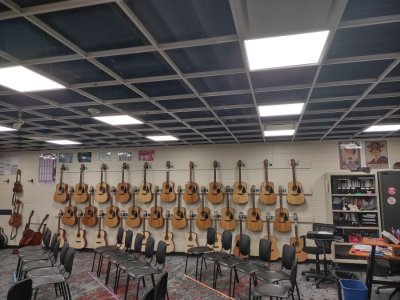Looking for ideas, especially if anyone has some experience with HVAC...
I'm a middle-school teacher that's lucky enough to have a lot of really nice instruments in my program (perhaps too nice, as you'll see...). For example, we have 30 solid mahogany Mainland ukuleles for students to use, as well as 25 solid-top Fender guitars. (Plus a whole lot of laminate instruments in addition, but those aren't really the focus of this question...)
The problem is that in the past couple of years, I was moved into a classroom that the humidity has become enough of an issue that I've had 6 ukes and 3 guitars crack just from hanging on the walls. For example, when I was gone for our Thanksgiving break, and the custodians didn't fill the humidifiers, the room humidity was less than 20% when I returned.
The school's trying to help; we have 2 whole-house humidifiers that are running non-stop. Each is rated for 3600 sq ft, and the room is 1400 sq ft. The custodians are now filling the humidifiers over the weekends, and each instrument has a little DIY humidifier that I designed a few years back. (Little plastic test-tubes with water beads in them...work quite well...) The instrument humidifiers, though, can only do so much when not sealed in a case with the instrument. The room has no windows, and maybe a 10 foot ceiling.)
In spite of these two big humidifiers (and now a third, smaller one) running non-stop, the best we've been able to raise the room humidity to is 32%. And, if the custodians are away for a day and can't re-fill the tanks (each one uses at least 6 gallons of water a day...), then the room humidity is back down to 20% or below.
I know cases might work better, but it's not a great solution for the circumstance. Regardless, my question for anyone out there is more about what might be getting in the way of getting the room humidity up to a decent level? I'm trying to brainstorm ideas with the school admin, and I'm puzzled with why it's not higher than it is when there's several humidifiers going strong...
Thank you!
I'm a middle-school teacher that's lucky enough to have a lot of really nice instruments in my program (perhaps too nice, as you'll see...). For example, we have 30 solid mahogany Mainland ukuleles for students to use, as well as 25 solid-top Fender guitars. (Plus a whole lot of laminate instruments in addition, but those aren't really the focus of this question...)
The problem is that in the past couple of years, I was moved into a classroom that the humidity has become enough of an issue that I've had 6 ukes and 3 guitars crack just from hanging on the walls. For example, when I was gone for our Thanksgiving break, and the custodians didn't fill the humidifiers, the room humidity was less than 20% when I returned.
The school's trying to help; we have 2 whole-house humidifiers that are running non-stop. Each is rated for 3600 sq ft, and the room is 1400 sq ft. The custodians are now filling the humidifiers over the weekends, and each instrument has a little DIY humidifier that I designed a few years back. (Little plastic test-tubes with water beads in them...work quite well...) The instrument humidifiers, though, can only do so much when not sealed in a case with the instrument. The room has no windows, and maybe a 10 foot ceiling.)
In spite of these two big humidifiers (and now a third, smaller one) running non-stop, the best we've been able to raise the room humidity to is 32%. And, if the custodians are away for a day and can't re-fill the tanks (each one uses at least 6 gallons of water a day...), then the room humidity is back down to 20% or below.
I know cases might work better, but it's not a great solution for the circumstance. Regardless, my question for anyone out there is more about what might be getting in the way of getting the room humidity up to a decent level? I'm trying to brainstorm ideas with the school admin, and I'm puzzled with why it's not higher than it is when there's several humidifiers going strong...
Thank you!


